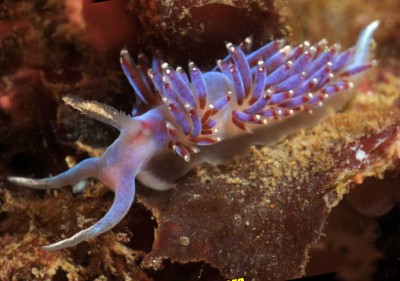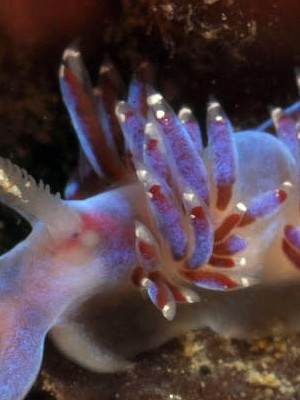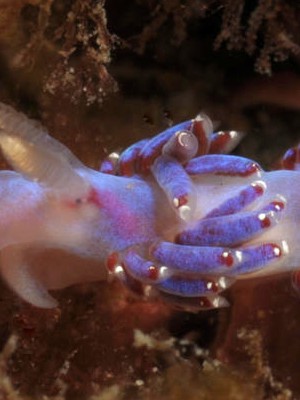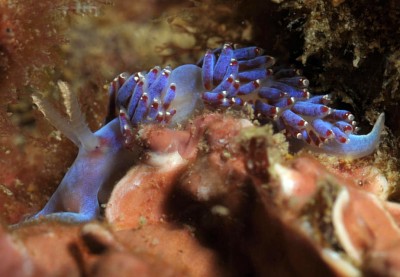Re:F. coronata or F. auriculata? from Spain
April 14, 2010
From: Miquel Pontes

Concerning message #4854:
Hi Bill,
We came across this interesting specimen of Facelina coronata which, according to some of the documentation available to us, was cited as Facelina auriculata. It was clear, after the forum message by Bernard Picton, that these two species are indeed the same.
I wanted to send you my pictures because it seems this Spanish F. auriculata has a brighter blue coloration than other pictures from other places published here, obviously this has some correlation with this animal feeding.
Locality: Aiguafreda, Begur, Costa Brava, 12 metres, Spain, Mediterranean Sea, 10 April 2010, Rocky bottom covered with calcareous algae. Length: 30 mm.. Photographer: Miquel Pontes.
Best regards,
Miquel Pontes
miquelpontes@gmail.com



Thanks Miquel,
I think the blue colouration is a surface skin colour and so is unlikely to be directly related to their food. Certainly the red colouration is food related because we can see that the digestive gland ducts in the cerata are red. In the close-ups I have included we can also see the oesophagus through the body wall, just behind the rhinophores, stuffed full of red 'food'. The close-ups also show how the blue patches are just on the outer side of the cerata and that they obscure the view of the red digestive gland.
It's probable that the blue is not in fact a pigment but rather a 'structural' colour caused by something in the skin cells which is reflecting or bending some light waves. In some species, such as Pteraeolidia ianthina, the blue or opalescent colour colour appears more intense when the ceratal contents are a darker colour. Perhaps the dark red digestive gland contents in your animal makes the blue more intense, or it could be related to the the angle of the light hitting the aeolid when you photographed it.
Best wishes,
Bill Rudman
Related messages
-
Re: Facelina auriculata from the French Mediterranean
From: Jean Michel Crouzet , May 6, 2010 -
Facelina auriculata from the French Mediterranean
From: Dominique Horst, April 14, 2010 -
Facelina ? from French Mediterranean coast
From: Sylvain Le Bris, August 21, 2008 -
Facelina auriculata from Plymouth, UK
From: Judith Oakley, August 14, 2006 -
Facelina auriculata from Cork, Ireland
From: Jamie Malone , June 15, 2006 -
Facelina auriculata, in Brittany
From: Stephane Ores, June 13, 2006 -
Facelina auriculata from Ireland
From: Jamie Malone ., May 2, 2006 -
Re: Flabellina pedata? from UK
From: Bernard Picton, September 30, 2005 -
Flabellina pedata? from UK
From: Judith Oakley, August 12, 2005 -
Facelina auriculata from sthn England
From: Jack Sewell, May 7, 2005 -
Facelina auriculata from Brittany
From: Marina Poddubetskaia, September 7, 2002 -
Facelina auriculata from Scotland
From: Jim Anderson, August 31, 2001 -
Re: Facelina auriculata in Scotland
From: Bernard Picton , August 31, 2001 -
Aeolid from Scotland
From: Erwin Koehler, August 30, 2001 -
Facelina coronata or F. auriculata?
From: Bernard Picton , July 22, 2001 -
Facelina coronata from the Netherlands
From: Peter H. van Bragt, August 13, 1999 -
Re: Mystery from Holland
From: Peter H. van Bragt, June 10, 1999 -
Facelina coronata f rom Mediterranean France
From: Daniel L. Geiger, June 5, 1999
